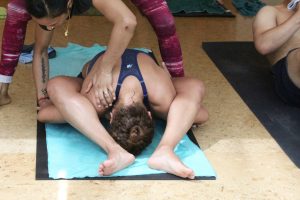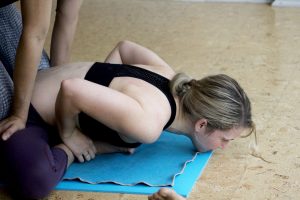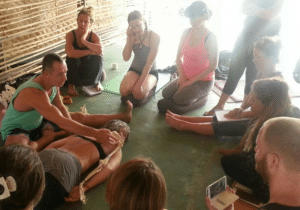Sometimes in this practice, we push through pain because we think the practice needs to look a certain way.
I remember when I first started practicing Ashtanga, I was so eager to “get” all the poses. I just wanted to be a “real” Ashtangi.
One who could do lotus, dropbacks, and put their leg behind their head. One who floated effortlessly from one pose to the next with ease. One who could, “at least”, complete the full primary series. To me, achieving these Asana’s was a measure of my success as an Ashtangi.
I remember trying to muscle my way through the marichyasana’s (which is a bad idea in case you were wondering). Each day my knee’s screamed at me, and each day, I ignored them. My former rugby playing, “no pain no gain” mentality tried to take the reigns. But I realized quickly it doesn’t quite work like that in Ashtanga.
The daily Sadhana makes it hard to ignore the pain signals from your body. And often, the pain only gets more amplified – especially in the knees and the back.

As yoga anatomy genius Stu Girling points out in his latest blog post:
When you experience pain it is in effect your body trying to talk to you. Perhaps it’s saying that it’s not happy with the aberrant alignment it finds itself in, the damage that has been done to it, the tension patterns that are building up, or on a positive note that structural change is taking place. More often than not it is saying ‘’back the hell off bitch’’.
Listen, we all experience pain in some way shape or form during our practice. It’s pretty much inevitable with a daily practice.
So this week we’re bringing you some simple tips on how to respond to pain during practice.
Here are 4 Tips for dealing with pain in practice:
1. Identify whether it’s pain or discomfort

This is a very important distinction. I always say that the practice of yoga isn’t about feeling calm, rather it’s about learning to sit with discomfort. But this is very different from pain, and it’s important that you make this distinction.
Sensations that are: sharp, shooting, stabbing, throbbing or numbing are generally indications of pain rather than discomfort and are signals that you should back off from what you’re doing. Stu makes a distinction between DOMS (delayed onset muscle soreness) in his article that is another important distinction. We can work, and breathe through DOMS, but should NOT work or breathe our way through straight up pain.
2. Back off

Ok, so once you’ve identified that what you’re experiencing is pain, you need to back off. Period. If something hurts you, it isn’t going to help you. Especially when it is knee or back pain. In Ashtanga we play the long game so to speak. It isn’t so much about who gets there quickest, it’s about who continues on. Consistency is key.
Call your teacher over and let them know what’s going on. They can help you with an appropriate modification, or suggest you omit that pose for the day, and until such time as you feel better.
Be mindful that this is a lifelong practice. When your body speaks to you, respond with love and compassion. If it is saying, “OUCH!” honor that, and show your body the love it deserves.
3. Sit with the discomfort

Listen, this is totally the pot calling the kettle black here, but for us Type-A Ashtangis, I get how difficult it can be to back off. I often feel guilt, maybe even shame around “admitting defeat” and backing off from an asana. It’s gotten a lot better, but its because I’ve learned to sit with those feelings I have when I choose to soften away from a painful asana in the moment.
My rugby brain is still re-wiring!
Notice how you feel when you back off. Are you hard on yourself? Does your inner critic call you lazy, weak, or some other not-so-nice name? As challenging as it may be, I encourage you to sit with those feelings. Allow them to be there, and let them pass. The work of the mind is just as much a part of the practice as the physical asana. Perhaps even harder. In these moments tap into your breath, and let this be your guide.
4. Enhance your understanding of correct alignment through workshops.

While having a consistent teacher is great, and they often give you helpful cues and tips in the practice room, I have found that taking workshops has been really helpful in understanding the various postures.
Workshops tend to focus on specific asana or a specific area of the body and take an in-depth look at how that asana/area of the body works. Some of my biggest “asana breakthroughs” happened while taking a workshop!
This September, we are lucky enough to have Yoga Anatomy Master Stu Girling at AYCT to teach some amazing workshops. Seriously, he is so smart, has decades of experience helping Ashtangis recover from injuries AND he has a British accent. And everything is better with a British accent.
You can check out his line up of workshops here. I would highly recommend signing up for the whole weekend – he’s so knowledgeable and he’s crossing land and sea to teach you all the things! Maybe we will see you there?!
